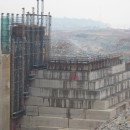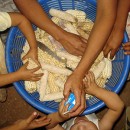Languages
Saturday, April 20, 2024
News and Views from the Global South
family farming
Peasants Marginalized by Big Farmers
A recent Food and Agriculture Organization (FAO) study shows the largest farms cultivate a high and increasing share of agricultural land in much of the world. Farm size concentration World Agricultural Census data for 129 countries show about 40% of the world’s farmland is operated by farms over 1000 hectares (ha) in size. About 70% is operated by the top 1% of farms, all bigger than 50 ha each.
Agricultural Power, Waning Industry Dictate Brazil’s Future
With its accelerated growth agriculture has emerged as a key sector of Brazil's economy, but it is failing on its own to spread prosperity and reduce poverty and inequality, with industry in decline.
Q&A: Family Farming in Latin America & the Caribbean Hard Hit by COVID-19 Restrictions
With limited transport options to carry their goods to the market, lack of protective gear, and limited financial resources, family farmers across Latin America are facing grave consequences as a result of the COVID-19 pandemic.
Family Farming Wages a Difficult Battle in Argentina
"Our philosophy is based on two principles: zero tolerance of pesticides or bosses," says Leandro Ladrú, while he puts tomatoes and carrots in the ecological bag held by a customer, in a large market in the Argentine capital, located between warehouses and rusty old railroad cars.
Even Rocks Harvest Water in Brazil’s Semi-Arid Northeast
Rocks, once a hindrance since they reduced arable land, have become an asset. Pedrina Pereira and João Leite used them to build four ponds to collect rainwater in a farming community in Brazil’s semi-arid Northeast.
Agroecology Beats Land and Water Scarcity in Brazil
"Now we live well," say both Givaldo and Nina dos Santos, after showing visiting farmers their 1.25-hectare farm in Brazil’s semi-arid Northeast, which is small but has a great variety of fruit trees, thanks to innovative water and production techniques.
Optimal Use of Water Works Miracles in Brazil’s Semi-Arid Region
Cattle ranching has been severely affected by drought in Brazi's Northeast region, but it has not only survived but has made a comeback in the Jacuípe river basin thanks to an optimal use of water.
Latin America in Search of Sustainable Food Systems
A paradigm shift is needed regarding how food is produced, consumed and marketed in Latin America and the Caribbean, in order to curb health problems related to poor nutrition.
Local Farmers and Consumers Create Short Food Supply Chains in Mexican Cities
Víctor Rodríguez arranges lettuce, broccoli, potatoes and herbs on a shelf with care, as he does every Sunday, preparing to serve the customers who are about to arrive at the Alternative Market of Bosque de Tlalpan, in the south of the Mexican capital.
Q&A: “It’s a Crime” that 35 Million Latin Americans Still Suffer from Hunger
The fight against hunger has been “remarkably successful” in Latin America and the Caribbean, but “it is a crime” that 35 million people still go to bed hungry every day, FAO regional representative Julio Berdegué told IPS.
New Recipe for School Meals Programmes in Latin America
Sunita Daniel remembers what the school lunch programmes were like in her Caribbean island nation, Saint Lucía, until a couple of years ago: meals made of processed foods and imported products, and little integration with the surrounding communities.
Climate Change Adaptation – Key to Reaching Zero Hunger in Latin America
Climate change is leading to major modifications in agricultural production in Latin America and the Caribbean, and if mitigation and adaptation measures of the productive system are not urgently adopted, threats to food security will be exacerbated.
The Family Garden Going Out of Style in Cuban Countryside
In the past, all rural homes in Cuba had gardens for putting fresh vegetables on the dinner table. The local term for these gardens is “conuco”, a word with indigenous roots that is still used in several Caribbean nations.
Latin American Legislators, a Battering Ram in the Fight Against Hunger
Lawmakers in Latin America are joining forces to strengthen institutional frameworks that sustain the fight against hunger in a region that, despite being dubbed “the next global breadbasket”, still has more than 34 million undernourished people.
Terrace Farming – an Ancient Indigenous Model for Food Security
Terrace farming as practiced from time immemorial by native peoples in the Andes mountains contributes to food security as a strategy of adaptation in an environment where the geography and other conditions make the production of nutritional foods a complex undertaking.
The Double Burden of Malnutrition
Not only do 805 million people go to bed hungry every day, with one-third of global food production (1.3 billion tons each year) being wasted, there is another scenario that reflects the nutrition paradox even more starkly: two billion people are affected by micronutrients deficiencies while 500 million individuals suffer from obesity.
Family Farmers – Forward to the Future
"Who is more concerned than the rural family with regards to preservation of natural resources for future generations?"












